FTO Learning, Training & Development: A Study of Brooklyn Hospital
VerifiedAdded on 2023/06/07
|7
|1835
|148
Report
AI Summary
This report reflects on the author's experience as a Field Training Officer (FTO) at Brooklyn Hospital Center, focusing on improving organizational communication. It addresses issues faced during a childhood obesity reduction program, highlighting the lack of coordination and synchronization among departments due to communication deficiencies. The report suggests incorporating digital technologies, training management and staff, creating collective recreational facilities, using employee handbooks, establishing an internal communication department, developing teamwork, and recognizing performance to enhance communication. Ultimately, the goal is to foster an organizational culture that promotes efficient communication among employees, thereby increasing productivity and improving patient care. The report concludes that effective communication relies on both staff abilities and management support in cultivating a communicative environment.
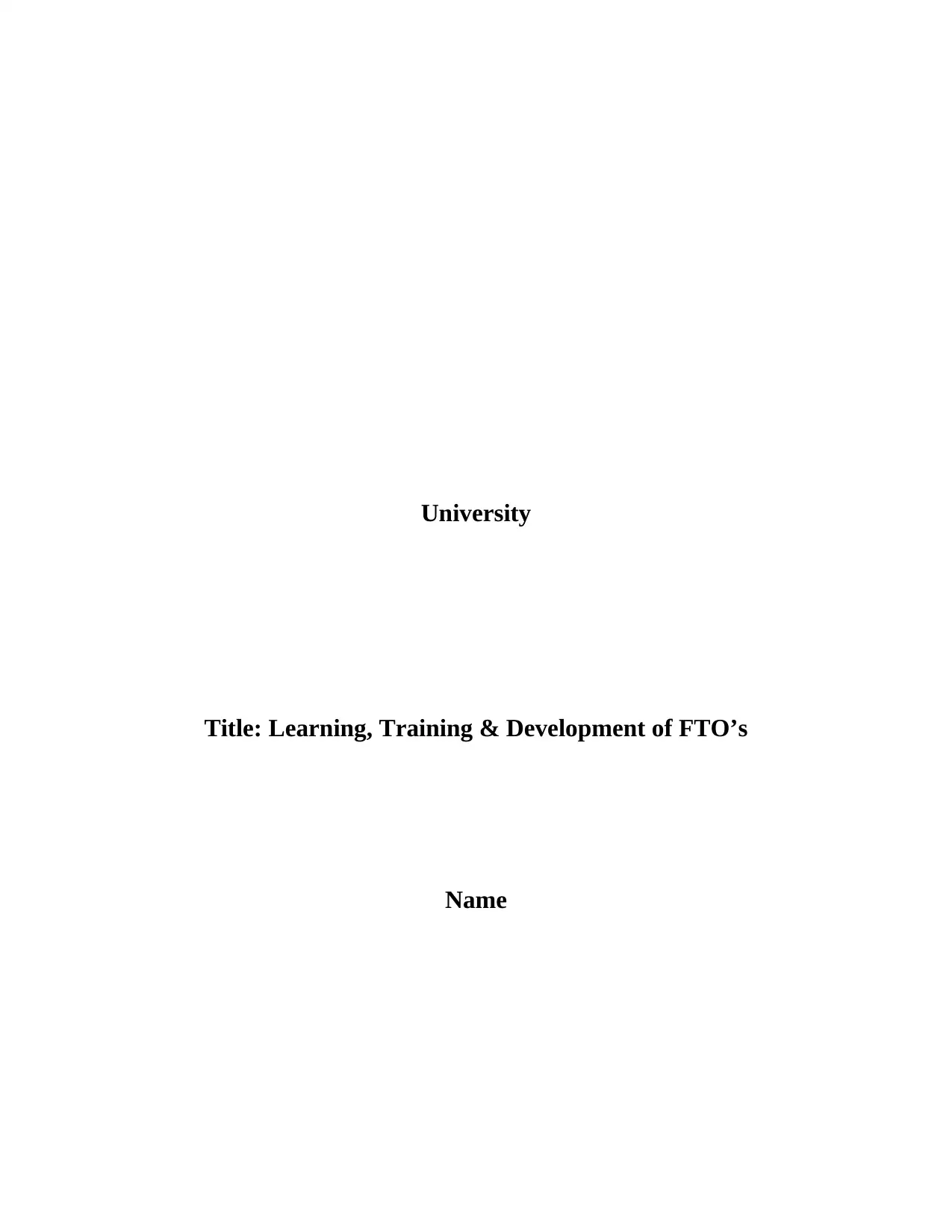
University
Title: Learning, Training & Development of FTO’s
Name
Title: Learning, Training & Development of FTO’s
Name
Paraphrase This Document
Need a fresh take? Get an instant paraphrase of this document with our AI Paraphraser
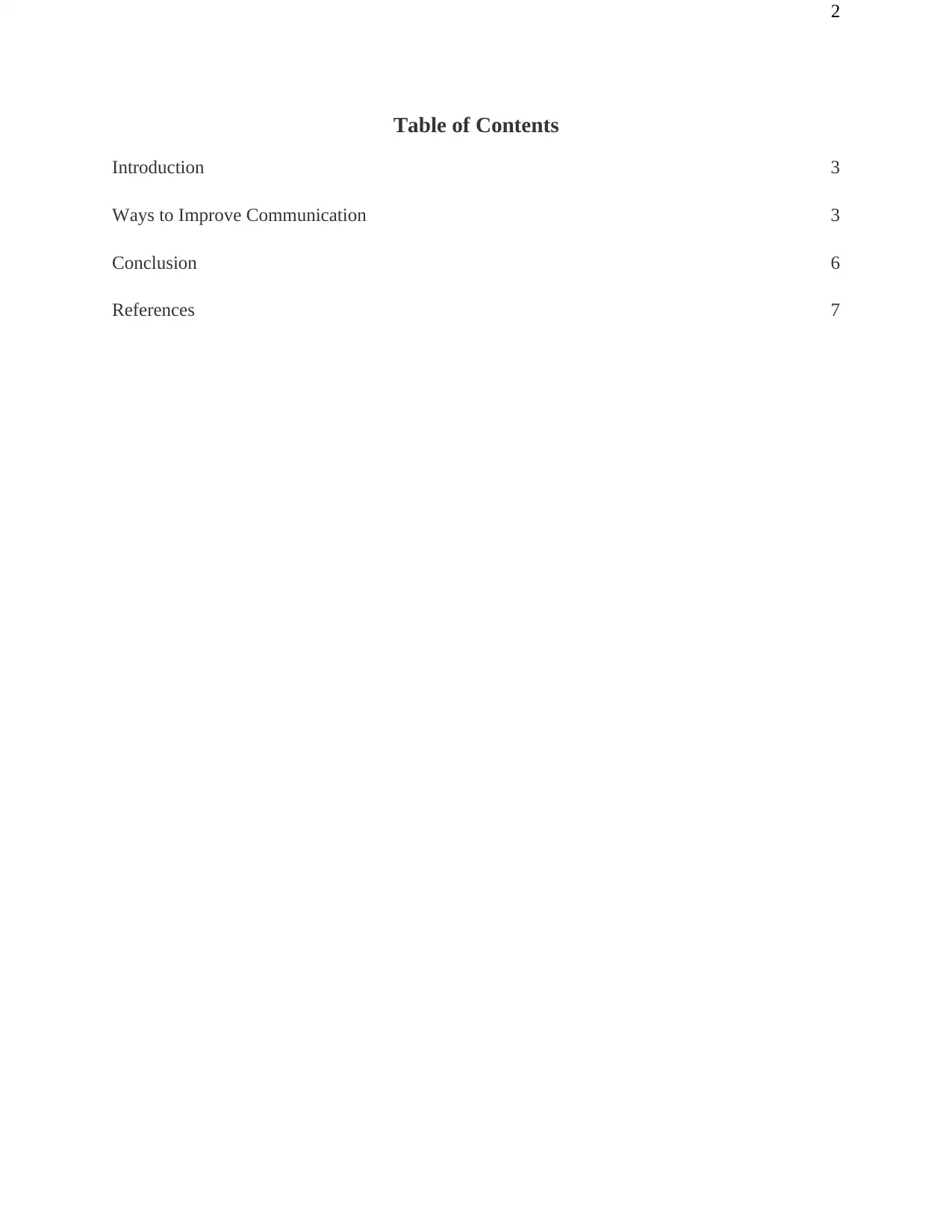
2
Table of Contents
Introduction 3
Ways to Improve Communication 3
Conclusion 6
References 7
Table of Contents
Introduction 3
Ways to Improve Communication 3
Conclusion 6
References 7
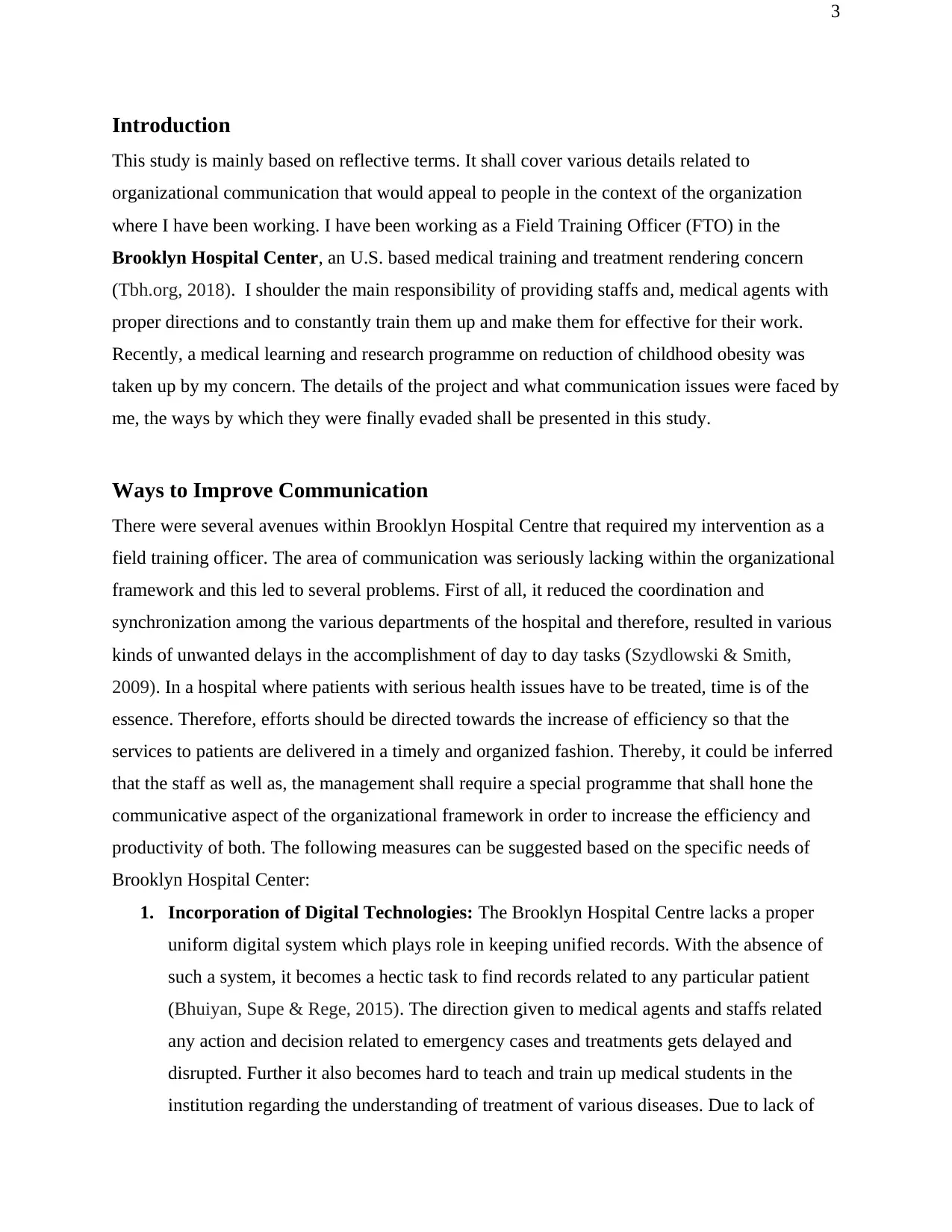
3
Introduction
This study is mainly based on reflective terms. It shall cover various details related to
organizational communication that would appeal to people in the context of the organization
where I have been working. I have been working as a Field Training Officer (FTO) in the
Brooklyn Hospital Center, an U.S. based medical training and treatment rendering concern
(Tbh.org, 2018). I shoulder the main responsibility of providing staffs and, medical agents with
proper directions and to constantly train them up and make them for effective for their work.
Recently, a medical learning and research programme on reduction of childhood obesity was
taken up by my concern. The details of the project and what communication issues were faced by
me, the ways by which they were finally evaded shall be presented in this study.
Ways to Improve Communication
There were several avenues within Brooklyn Hospital Centre that required my intervention as a
field training officer. The area of communication was seriously lacking within the organizational
framework and this led to several problems. First of all, it reduced the coordination and
synchronization among the various departments of the hospital and therefore, resulted in various
kinds of unwanted delays in the accomplishment of day to day tasks (Szydlowski & Smith,
2009). In a hospital where patients with serious health issues have to be treated, time is of the
essence. Therefore, efforts should be directed towards the increase of efficiency so that the
services to patients are delivered in a timely and organized fashion. Thereby, it could be inferred
that the staff as well as, the management shall require a special programme that shall hone the
communicative aspect of the organizational framework in order to increase the efficiency and
productivity of both. The following measures can be suggested based on the specific needs of
Brooklyn Hospital Center:
1. Incorporation of Digital Technologies: The Brooklyn Hospital Centre lacks a proper
uniform digital system which plays role in keeping unified records. With the absence of
such a system, it becomes a hectic task to find records related to any particular patient
(Bhuiyan, Supe & Rege, 2015). The direction given to medical agents and staffs related
any action and decision related to emergency cases and treatments gets delayed and
disrupted. Further it also becomes hard to teach and train up medical students in the
institution regarding the understanding of treatment of various diseases. Due to lack of
Introduction
This study is mainly based on reflective terms. It shall cover various details related to
organizational communication that would appeal to people in the context of the organization
where I have been working. I have been working as a Field Training Officer (FTO) in the
Brooklyn Hospital Center, an U.S. based medical training and treatment rendering concern
(Tbh.org, 2018). I shoulder the main responsibility of providing staffs and, medical agents with
proper directions and to constantly train them up and make them for effective for their work.
Recently, a medical learning and research programme on reduction of childhood obesity was
taken up by my concern. The details of the project and what communication issues were faced by
me, the ways by which they were finally evaded shall be presented in this study.
Ways to Improve Communication
There were several avenues within Brooklyn Hospital Centre that required my intervention as a
field training officer. The area of communication was seriously lacking within the organizational
framework and this led to several problems. First of all, it reduced the coordination and
synchronization among the various departments of the hospital and therefore, resulted in various
kinds of unwanted delays in the accomplishment of day to day tasks (Szydlowski & Smith,
2009). In a hospital where patients with serious health issues have to be treated, time is of the
essence. Therefore, efforts should be directed towards the increase of efficiency so that the
services to patients are delivered in a timely and organized fashion. Thereby, it could be inferred
that the staff as well as, the management shall require a special programme that shall hone the
communicative aspect of the organizational framework in order to increase the efficiency and
productivity of both. The following measures can be suggested based on the specific needs of
Brooklyn Hospital Center:
1. Incorporation of Digital Technologies: The Brooklyn Hospital Centre lacks a proper
uniform digital system which plays role in keeping unified records. With the absence of
such a system, it becomes a hectic task to find records related to any particular patient
(Bhuiyan, Supe & Rege, 2015). The direction given to medical agents and staffs related
any action and decision related to emergency cases and treatments gets delayed and
disrupted. Further it also becomes hard to teach and train up medical students in the
institution regarding the understanding of treatment of various diseases. Due to lack of
⊘ This is a preview!⊘
Do you want full access?
Subscribe today to unlock all pages.

Trusted by 1+ million students worldwide
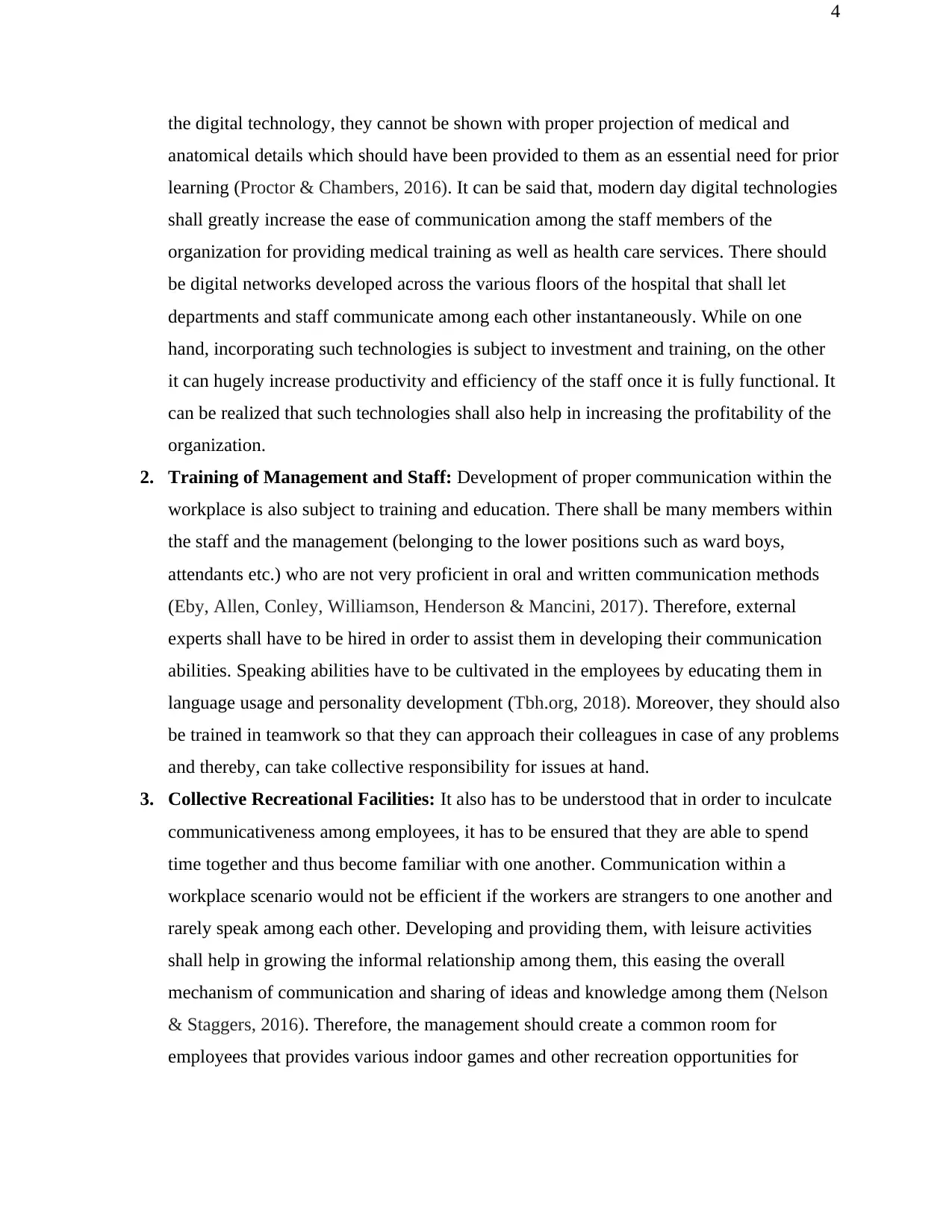
4
the digital technology, they cannot be shown with proper projection of medical and
anatomical details which should have been provided to them as an essential need for prior
learning (Proctor & Chambers, 2016). It can be said that, modern day digital technologies
shall greatly increase the ease of communication among the staff members of the
organization for providing medical training as well as health care services. There should
be digital networks developed across the various floors of the hospital that shall let
departments and staff communicate among each other instantaneously. While on one
hand, incorporating such technologies is subject to investment and training, on the other
it can hugely increase productivity and efficiency of the staff once it is fully functional. It
can be realized that such technologies shall also help in increasing the profitability of the
organization.
2. Training of Management and Staff: Development of proper communication within the
workplace is also subject to training and education. There shall be many members within
the staff and the management (belonging to the lower positions such as ward boys,
attendants etc.) who are not very proficient in oral and written communication methods
(Eby, Allen, Conley, Williamson, Henderson & Mancini, 2017). Therefore, external
experts shall have to be hired in order to assist them in developing their communication
abilities. Speaking abilities have to be cultivated in the employees by educating them in
language usage and personality development (Tbh.org, 2018). Moreover, they should also
be trained in teamwork so that they can approach their colleagues in case of any problems
and thereby, can take collective responsibility for issues at hand.
3. Collective Recreational Facilities: It also has to be understood that in order to inculcate
communicativeness among employees, it has to be ensured that they are able to spend
time together and thus become familiar with one another. Communication within a
workplace scenario would not be efficient if the workers are strangers to one another and
rarely speak among each other. Developing and providing them, with leisure activities
shall help in growing the informal relationship among them, this easing the overall
mechanism of communication and sharing of ideas and knowledge among them (Nelson
& Staggers, 2016). Therefore, the management should create a common room for
employees that provides various indoor games and other recreation opportunities for
the digital technology, they cannot be shown with proper projection of medical and
anatomical details which should have been provided to them as an essential need for prior
learning (Proctor & Chambers, 2016). It can be said that, modern day digital technologies
shall greatly increase the ease of communication among the staff members of the
organization for providing medical training as well as health care services. There should
be digital networks developed across the various floors of the hospital that shall let
departments and staff communicate among each other instantaneously. While on one
hand, incorporating such technologies is subject to investment and training, on the other
it can hugely increase productivity and efficiency of the staff once it is fully functional. It
can be realized that such technologies shall also help in increasing the profitability of the
organization.
2. Training of Management and Staff: Development of proper communication within the
workplace is also subject to training and education. There shall be many members within
the staff and the management (belonging to the lower positions such as ward boys,
attendants etc.) who are not very proficient in oral and written communication methods
(Eby, Allen, Conley, Williamson, Henderson & Mancini, 2017). Therefore, external
experts shall have to be hired in order to assist them in developing their communication
abilities. Speaking abilities have to be cultivated in the employees by educating them in
language usage and personality development (Tbh.org, 2018). Moreover, they should also
be trained in teamwork so that they can approach their colleagues in case of any problems
and thereby, can take collective responsibility for issues at hand.
3. Collective Recreational Facilities: It also has to be understood that in order to inculcate
communicativeness among employees, it has to be ensured that they are able to spend
time together and thus become familiar with one another. Communication within a
workplace scenario would not be efficient if the workers are strangers to one another and
rarely speak among each other. Developing and providing them, with leisure activities
shall help in growing the informal relationship among them, this easing the overall
mechanism of communication and sharing of ideas and knowledge among them (Nelson
& Staggers, 2016). Therefore, the management should create a common room for
employees that provides various indoor games and other recreation opportunities for
Paraphrase This Document
Need a fresh take? Get an instant paraphrase of this document with our AI Paraphraser
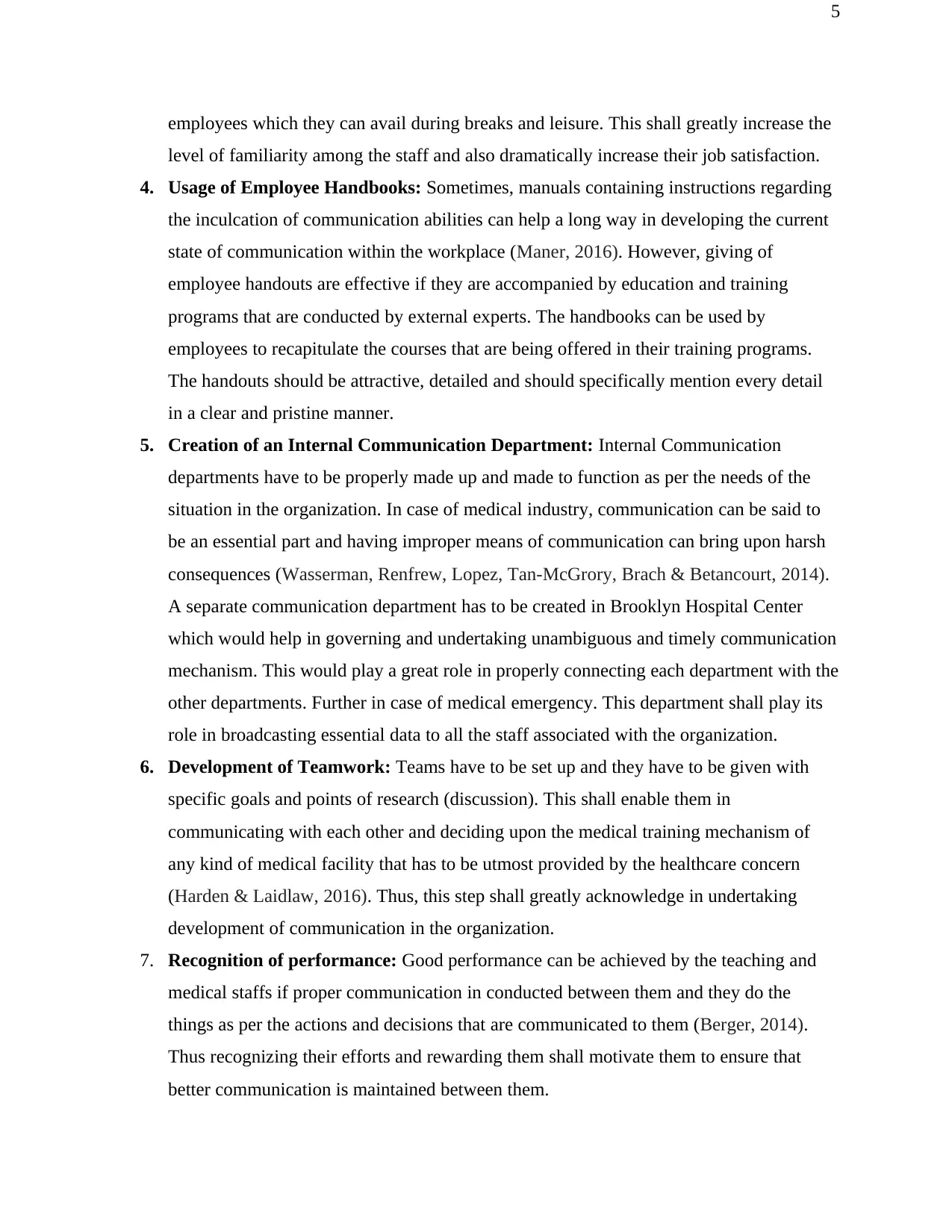
5
employees which they can avail during breaks and leisure. This shall greatly increase the
level of familiarity among the staff and also dramatically increase their job satisfaction.
4. Usage of Employee Handbooks: Sometimes, manuals containing instructions regarding
the inculcation of communication abilities can help a long way in developing the current
state of communication within the workplace (Maner, 2016). However, giving of
employee handouts are effective if they are accompanied by education and training
programs that are conducted by external experts. The handbooks can be used by
employees to recapitulate the courses that are being offered in their training programs.
The handouts should be attractive, detailed and should specifically mention every detail
in a clear and pristine manner.
5. Creation of an Internal Communication Department: Internal Communication
departments have to be properly made up and made to function as per the needs of the
situation in the organization. In case of medical industry, communication can be said to
be an essential part and having improper means of communication can bring upon harsh
consequences (Wasserman, Renfrew, Lopez, Tan‐McGrory, Brach & Betancourt, 2014).
A separate communication department has to be created in Brooklyn Hospital Center
which would help in governing and undertaking unambiguous and timely communication
mechanism. This would play a great role in properly connecting each department with the
other departments. Further in case of medical emergency. This department shall play its
role in broadcasting essential data to all the staff associated with the organization.
6. Development of Teamwork: Teams have to be set up and they have to be given with
specific goals and points of research (discussion). This shall enable them in
communicating with each other and deciding upon the medical training mechanism of
any kind of medical facility that has to be utmost provided by the healthcare concern
(Harden & Laidlaw, 2016). Thus, this step shall greatly acknowledge in undertaking
development of communication in the organization.
7. Recognition of performance: Good performance can be achieved by the teaching and
medical staffs if proper communication in conducted between them and they do the
things as per the actions and decisions that are communicated to them (Berger, 2014).
Thus recognizing their efforts and rewarding them shall motivate them to ensure that
better communication is maintained between them.
employees which they can avail during breaks and leisure. This shall greatly increase the
level of familiarity among the staff and also dramatically increase their job satisfaction.
4. Usage of Employee Handbooks: Sometimes, manuals containing instructions regarding
the inculcation of communication abilities can help a long way in developing the current
state of communication within the workplace (Maner, 2016). However, giving of
employee handouts are effective if they are accompanied by education and training
programs that are conducted by external experts. The handbooks can be used by
employees to recapitulate the courses that are being offered in their training programs.
The handouts should be attractive, detailed and should specifically mention every detail
in a clear and pristine manner.
5. Creation of an Internal Communication Department: Internal Communication
departments have to be properly made up and made to function as per the needs of the
situation in the organization. In case of medical industry, communication can be said to
be an essential part and having improper means of communication can bring upon harsh
consequences (Wasserman, Renfrew, Lopez, Tan‐McGrory, Brach & Betancourt, 2014).
A separate communication department has to be created in Brooklyn Hospital Center
which would help in governing and undertaking unambiguous and timely communication
mechanism. This would play a great role in properly connecting each department with the
other departments. Further in case of medical emergency. This department shall play its
role in broadcasting essential data to all the staff associated with the organization.
6. Development of Teamwork: Teams have to be set up and they have to be given with
specific goals and points of research (discussion). This shall enable them in
communicating with each other and deciding upon the medical training mechanism of
any kind of medical facility that has to be utmost provided by the healthcare concern
(Harden & Laidlaw, 2016). Thus, this step shall greatly acknowledge in undertaking
development of communication in the organization.
7. Recognition of performance: Good performance can be achieved by the teaching and
medical staffs if proper communication in conducted between them and they do the
things as per the actions and decisions that are communicated to them (Berger, 2014).
Thus recognizing their efforts and rewarding them shall motivate them to ensure that
better communication is maintained between them.
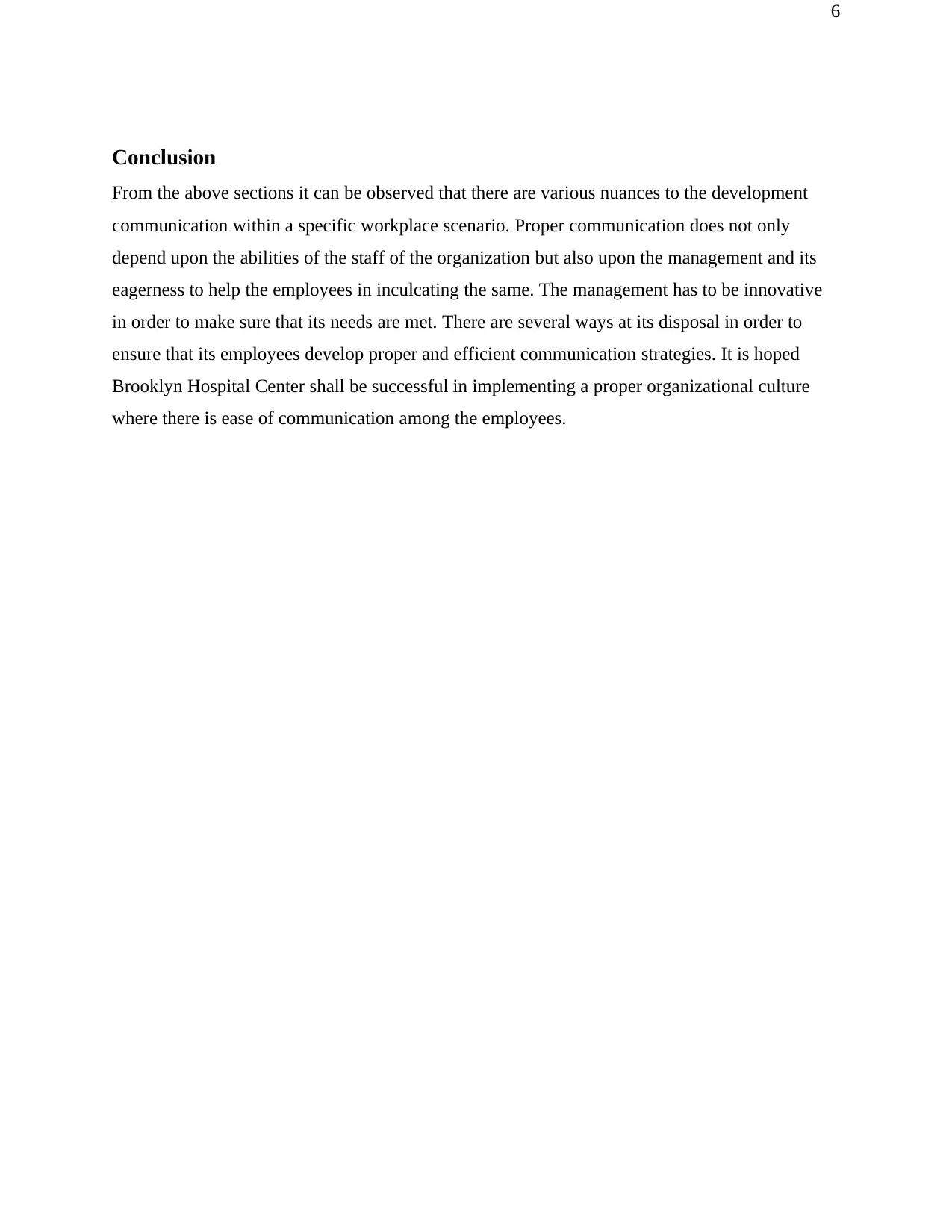
6
Conclusion
From the above sections it can be observed that there are various nuances to the development
communication within a specific workplace scenario. Proper communication does not only
depend upon the abilities of the staff of the organization but also upon the management and its
eagerness to help the employees in inculcating the same. The management has to be innovative
in order to make sure that its needs are met. There are several ways at its disposal in order to
ensure that its employees develop proper and efficient communication strategies. It is hoped
Brooklyn Hospital Center shall be successful in implementing a proper organizational culture
where there is ease of communication among the employees.
Conclusion
From the above sections it can be observed that there are various nuances to the development
communication within a specific workplace scenario. Proper communication does not only
depend upon the abilities of the staff of the organization but also upon the management and its
eagerness to help the employees in inculcating the same. The management has to be innovative
in order to make sure that its needs are met. There are several ways at its disposal in order to
ensure that its employees develop proper and efficient communication strategies. It is hoped
Brooklyn Hospital Center shall be successful in implementing a proper organizational culture
where there is ease of communication among the employees.
⊘ This is a preview!⊘
Do you want full access?
Subscribe today to unlock all pages.

Trusted by 1+ million students worldwide
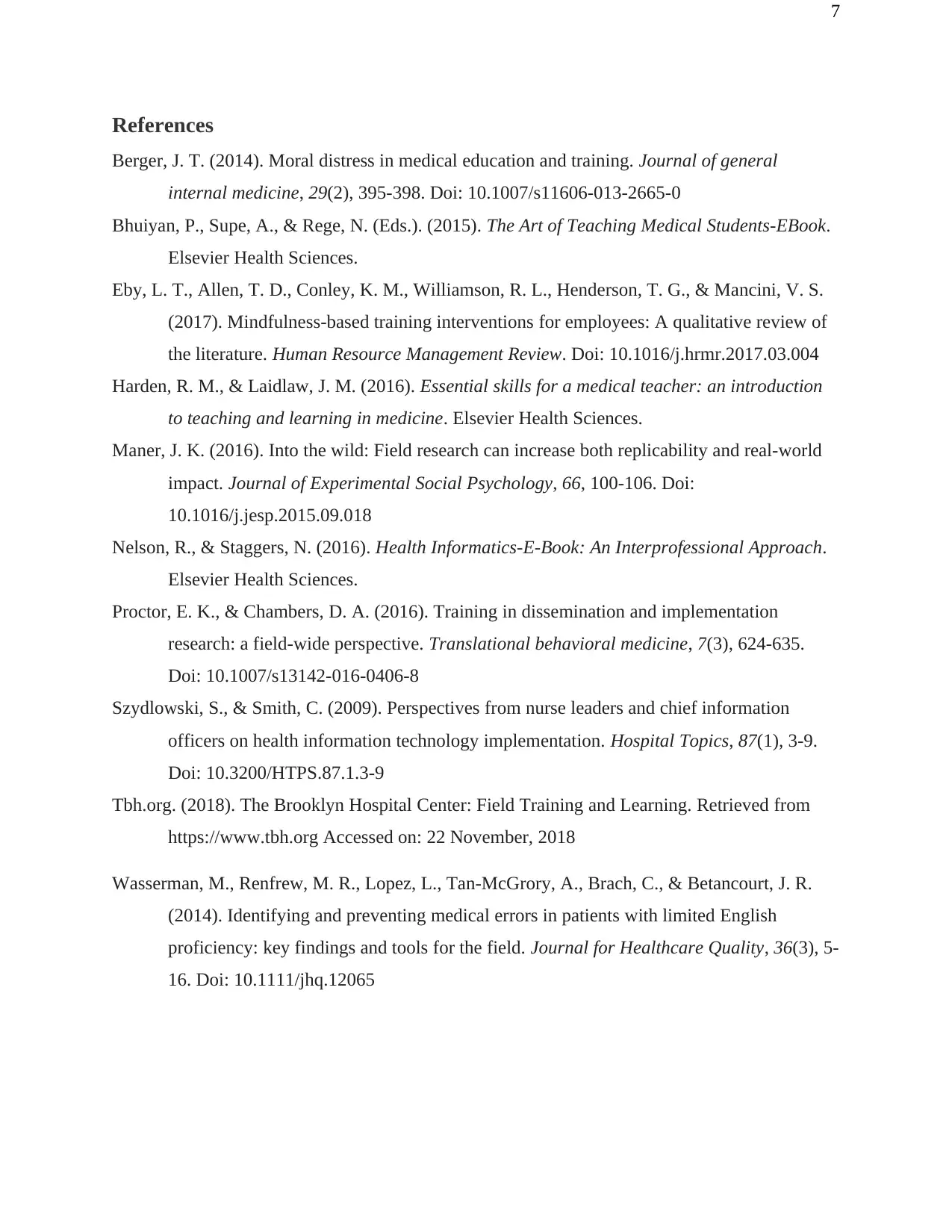
7
References
Berger, J. T. (2014). Moral distress in medical education and training. Journal of general
internal medicine, 29(2), 395-398. Doi: 10.1007/s11606-013-2665-0
Bhuiyan, P., Supe, A., & Rege, N. (Eds.). (2015). The Art of Teaching Medical Students-EBook.
Elsevier Health Sciences.
Eby, L. T., Allen, T. D., Conley, K. M., Williamson, R. L., Henderson, T. G., & Mancini, V. S.
(2017). Mindfulness-based training interventions for employees: A qualitative review of
the literature. Human Resource Management Review. Doi: 10.1016/j.hrmr.2017.03.004
Harden, R. M., & Laidlaw, J. M. (2016). Essential skills for a medical teacher: an introduction
to teaching and learning in medicine. Elsevier Health Sciences.
Maner, J. K. (2016). Into the wild: Field research can increase both replicability and real-world
impact. Journal of Experimental Social Psychology, 66, 100-106. Doi:
10.1016/j.jesp.2015.09.018
Nelson, R., & Staggers, N. (2016). Health Informatics-E-Book: An Interprofessional Approach.
Elsevier Health Sciences.
Proctor, E. K., & Chambers, D. A. (2016). Training in dissemination and implementation
research: a field-wide perspective. Translational behavioral medicine, 7(3), 624-635.
Doi: 10.1007/s13142-016-0406-8
Szydlowski, S., & Smith, C. (2009). Perspectives from nurse leaders and chief information
officers on health information technology implementation. Hospital Topics, 87(1), 3-9.
Doi: 10.3200/HTPS.87.1.3-9
Tbh.org. (2018). The Brooklyn Hospital Center: Field Training and Learning. Retrieved from
https://www.tbh.org Accessed on: 22 November, 2018
Wasserman, M., Renfrew, M. R., Lopez, L., Tan‐McGrory, A., Brach, C., & Betancourt, J. R.
(2014). Identifying and preventing medical errors in patients with limited English
proficiency: key findings and tools for the field. Journal for Healthcare Quality, 36(3), 5-
16. Doi: 10.1111/jhq.12065
References
Berger, J. T. (2014). Moral distress in medical education and training. Journal of general
internal medicine, 29(2), 395-398. Doi: 10.1007/s11606-013-2665-0
Bhuiyan, P., Supe, A., & Rege, N. (Eds.). (2015). The Art of Teaching Medical Students-EBook.
Elsevier Health Sciences.
Eby, L. T., Allen, T. D., Conley, K. M., Williamson, R. L., Henderson, T. G., & Mancini, V. S.
(2017). Mindfulness-based training interventions for employees: A qualitative review of
the literature. Human Resource Management Review. Doi: 10.1016/j.hrmr.2017.03.004
Harden, R. M., & Laidlaw, J. M. (2016). Essential skills for a medical teacher: an introduction
to teaching and learning in medicine. Elsevier Health Sciences.
Maner, J. K. (2016). Into the wild: Field research can increase both replicability and real-world
impact. Journal of Experimental Social Psychology, 66, 100-106. Doi:
10.1016/j.jesp.2015.09.018
Nelson, R., & Staggers, N. (2016). Health Informatics-E-Book: An Interprofessional Approach.
Elsevier Health Sciences.
Proctor, E. K., & Chambers, D. A. (2016). Training in dissemination and implementation
research: a field-wide perspective. Translational behavioral medicine, 7(3), 624-635.
Doi: 10.1007/s13142-016-0406-8
Szydlowski, S., & Smith, C. (2009). Perspectives from nurse leaders and chief information
officers on health information technology implementation. Hospital Topics, 87(1), 3-9.
Doi: 10.3200/HTPS.87.1.3-9
Tbh.org. (2018). The Brooklyn Hospital Center: Field Training and Learning. Retrieved from
https://www.tbh.org Accessed on: 22 November, 2018
Wasserman, M., Renfrew, M. R., Lopez, L., Tan‐McGrory, A., Brach, C., & Betancourt, J. R.
(2014). Identifying and preventing medical errors in patients with limited English
proficiency: key findings and tools for the field. Journal for Healthcare Quality, 36(3), 5-
16. Doi: 10.1111/jhq.12065
1 out of 7
Related Documents
Your All-in-One AI-Powered Toolkit for Academic Success.
+13062052269
info@desklib.com
Available 24*7 on WhatsApp / Email
![[object Object]](/_next/static/media/star-bottom.7253800d.svg)
Unlock your academic potential
Copyright © 2020–2025 A2Z Services. All Rights Reserved. Developed and managed by ZUCOL.





